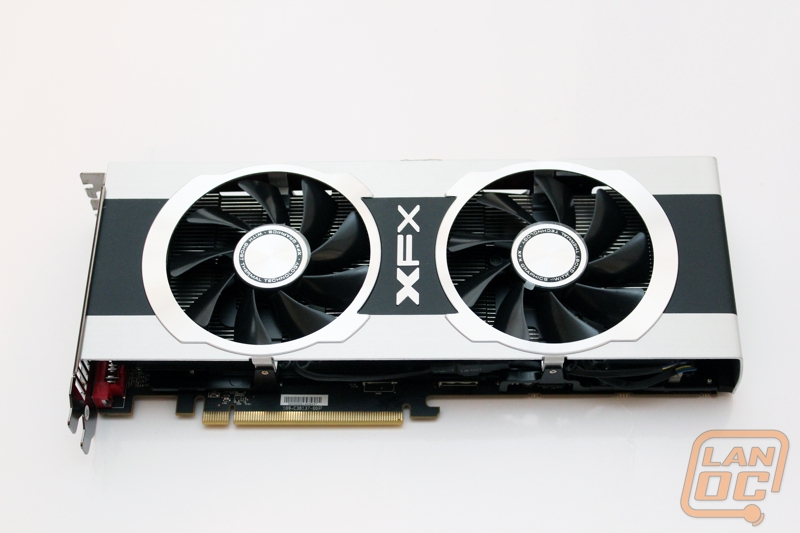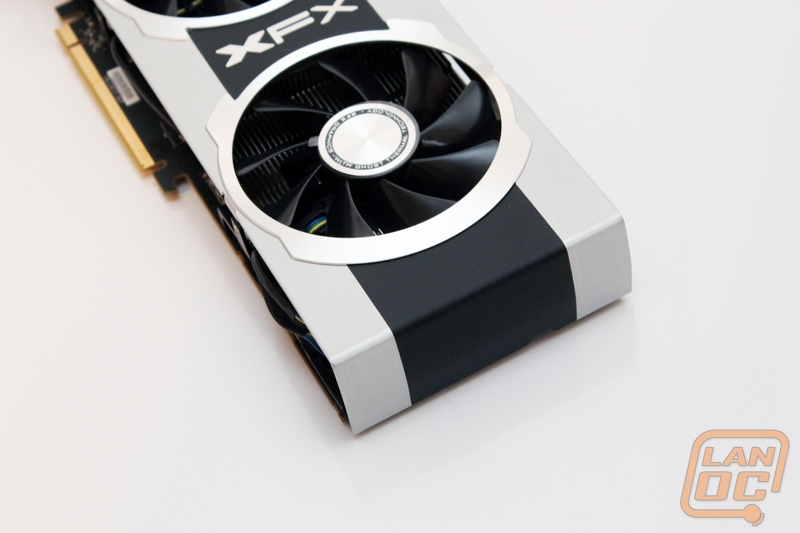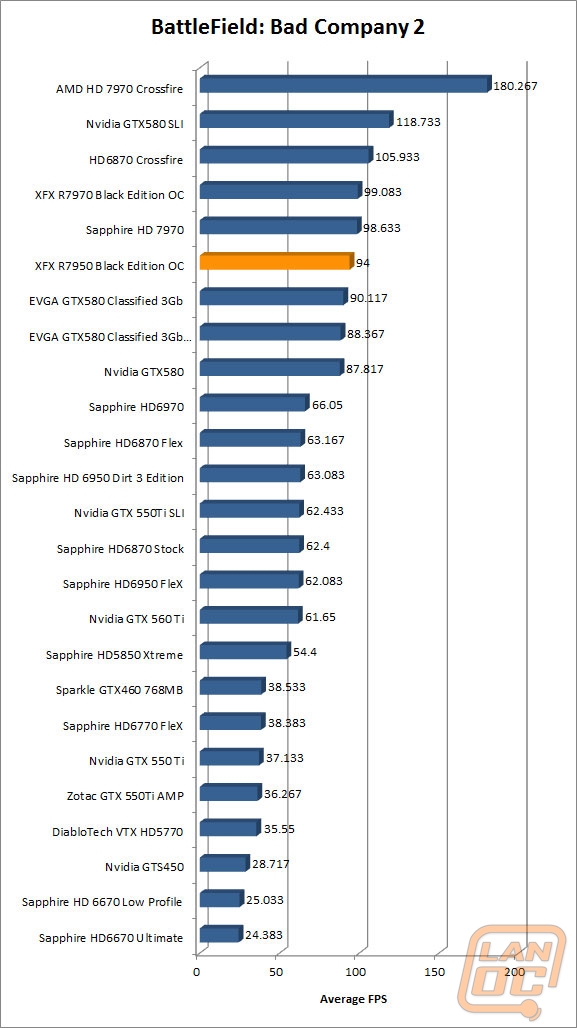 With AMD’s new HD 7970’s rocking the boat slightly with both price and performance it’s about time we started to see the slow trickle of GPU’s that will fill in the rest of the HD 7000 series video cards. First on the list is the HD 7950, a card that a lot of people have been waiting for because of the high price of the HD 7970. There is no doubt that it’s not going to outperform the HD 7970, but how will this new card compare to the GTX 580? Today I’m not taking a look at a reference card, we have skipped directly to the XFX Double Dissipation Black Edition Overclocked version, similar in design to what we saw with their R7970.
With AMD’s new HD 7970’s rocking the boat slightly with both price and performance it’s about time we started to see the slow trickle of GPU’s that will fill in the rest of the HD 7000 series video cards. First on the list is the HD 7950, a card that a lot of people have been waiting for because of the high price of the HD 7970. There is no doubt that it’s not going to outperform the HD 7970, but how will this new card compare to the GTX 580? Today I’m not taking a look at a reference card, we have skipped directly to the XFX Double Dissipation Black Edition Overclocked version, similar in design to what we saw with their R7970.
Product Name: XFX R7950 DD Black Edition Overclocked
Review Sample Provided by: XFX
Review by: Wes
Pictures by: Wes

Specifications
|
Part Number |
FX-795A-TDBC |
|
Model |
Radeon HD |
|
GPU |
7950 |
|
Performance Level |
Black Edition |
|
Core Clock |
900 MHz |
|
Memory Size |
3GB |
|
Memory Type |
GDDR5 |
|
Memory Bus |
384-bit |
|
Bus |
PCI-Express 3.0 |
|
|
2x Mini-DisplayPort 1x DVI-I 1x HDMI |
|
Fan Type |
Dual Axial |
|
XFACTOR Features |
• GPU Edging: Black Edition Selection Process • Double Dissipation • Ghost Thermal Technology • HydroCell Thermal Solution • Duratec: Solid Capacitors • Duratec: Ferrite Core • Duratec: 2oz Copper PCB • Duratec: IP-5X Dust Free Fan • Duratec: XFX Bracket |
Packaging
The XFX DD Black Edition Overclocked came in a box that is exactly the same as the R7970 other than the one digit difference on the cover. Along the bottom you have the HD 7950’s system requirements and a very long list of Key Features on the side of the packaging also. On the other side and the rear you have different breakdowns of the cards important features with photo examples of things like Tessellation Depth, Resident Textures, and increased Physics.


Inside the original box is a second black box.

Inside that box you have the card in the bottom wrapped up in a static protectant bag. On top you have a tray with all of the R7950’s documentation and accessories. You get a kick ass case badge, a crossfire cable, and an HDMI to DVI adapter cable. Most notable in the documentation, and something I pointed out on the R7970, is the Do No Disturb door hanger. This door hanger is cool but on the back you have your cards serial number and a place to write down your XFX support login information in case you ever have a problem with your card.



Card Layout
Its hard to not spot the similarities between the R7950 and the R7970. With the two cards next to each other even there are only a few things that stand out like the R7950’s two 6 pin connections. It isn’t until I flip them over that I see a few more differences. You can see that the R7950 is a few millimeters shorter than the R7970 causing the double dissipation cooler to hangover slightly. To keep that gap from pushing out more air XFX has placed a little foam. That is a little ironic considering the whole bottom of the cooler is open also.




The R7950’s backplate is similar to the R7970’s with two Display Port connections, one HDMI, and one DVI. The backplate has the XFX logo cut out of it and should give better air flow over the reference design.

Unlike the HD 7970 the lower powered HD 7950 only requires two six pin connections.

The R7950 has a flat black PCB. The XFX heatsink is attached in 12 different locations making for a lot of work if you want to pull it off and change your thermal paste.

You also get two crossfire connections meaning you can run up to four of these monsters in crossfire in the future!

For cooling you have XFX’s Double Dissipation heatsink. Far from the average cooler they have packed two fans into an all-aluminum chassis that is both sexy and functional. Other than the open bottom section this non-reference design is only of only a few that blows air back out the back. Normally only the reference cooler will do this, your other PC components will thank you for not letting all of that extra air get pushed into your case.



Our Test Rig
Asus Rampage IV X79 Motherboard
Seagate Constellation 2tb Hard drive
Cooler Master Gold Series 1200 Watt PSU
http://www.highspeedpc.com/ Test Bench
Kingston 1600Mhz DDR3 Quad Channel Ram
Kingston Hyper X 120 SSD’s in Raid 0
Our Testing Procedures
Battlefield Bad Company 2 (1920x1080 – high settings, first scene starting after the cut scene, recorded using fraps)
Dirt 2 (1920x1080 – 4x MSAA – high settings, in-game benchmark)
Dirt 3 (192x1080 - 4xMSAA - high settings, in-game benchmark)
Metro 2033 DX11 (built-in benchmark, 1920 x 1080; DirectX: DirectX 11; Quality: Very High; Antialiasing: MSAA 4X; Texture filtering: AF 4X; Advanced PhysX: Enabled; Tessellation: Enabled; DOF: Disabled)
Metro 2033 DX10 (built-in benchmark, 1920 x 1080; DirectX: DirectX 10; Quality: Very High; Antialiasing: MSAA 4X; Texture filtering: AF 4X; Advanced PhysX: Enabled; Tessellation: Enabled; DOF: Disabled)
Total War: Shogun 2 Direct X11 Benchmark High setting
Crysis 2 Using Adrenaline Crysis 2 benchmark two runs. The first set of runs set to ultra-settings, 1080p, 4x Anti-Aliasing, DX11, Laplace Edge Detection Edge AA, on the Times Square map, with hi res textures turned on. The second benchmark set to Xtreme at 1080p, no AA, DX9, Edge Blur, Hi-Res Textures turned off on the Times Square Map.
Battlefield 3 Using Fraps with the game set to Ultra settings with 4x MSAA Antialiasing Deferred, 16X Anisotropic Filter, at 1920x1080.
Synthetic Benchmarks For video cards our synthetic benchmarks are limited to 3DMark Vantage and 3DMark Vantage 2011. 3DMark Vantage is run with PPU turned off with results from both the performance and high settings. In 3DMark Vantage 2011 we run both performance and extreme benchmarks
FurMark We use Furmark to push the video card to the limit and test its cooling performance. Keep in mind that FurMark pushes cards well beyond what they would ever do in game. Our tests are done using the built in 1080p benchmark.
Cooling and Noise
To put the Double Dissipation cooling to the test on the HD 7950 we put Furmark on under the 1080p benchmark. The actually benchmark result was considerably lower than what we saw with the HD 7907, but this overclocked card ran a lot cooler than its bigger brother. With temperatures reaching 68 degree’s during the benchmark it was actually really close to what we saw with the reference HD 7970. Without a reference HD 7950 it’s hard to say how this compares to the reference cooler this time around but considering Furmark is an extreme way to heat your card up I am confident that this overclocked card will never have to worry about overheating issues. What was even more impressive to me was the improvements XFX did with noise, a remapped fan profile made a world of difference in the noise output for the R7950, one of our complaints of the R7970. It’s not that the cooling can’t be loud, it can be and will be if you ramp it up to 100%. But when letting the card control the fan speed it does a good job of balancing cooling performance while keeping the noise down.

3DMark
First things first, I should point out that the benchmark results between our HD 7970 testing and the new HD 7950 are running on two different drivers. That will account for a slight increase in performance compared to the HD 7970 in some cases as some of you may have seen with our last two crossfire benchmark posts. Of course that only accounts for some of it. The truth is the XFX R7950 out performed all of our GTX 580 benchmarks including the GTX 580 Classified and the classified overclocked in most cases. It’s one thing for AMD’s flagship card to beat the GTX 580, but for their second card to beat it is very impressive. Of course this is only going off of our results with the overclocked XFX DD Black Edition card. Frankly in a lot of cases this overclocked card comes very close to the performance we saw with the stock HD 7970, something I think a lot of people will take note of when considering the price difference between the two.




In Game Performance
While looking through our in game benchmarks, you will notice a few oddities. For one Dirt 2 and Dirt 3 had major single card performance increases with the new driver, that is why we actually saw better performance with the R7950 over the R7970. But where the R7950 excelled is performance in games like Crysis 2 with all of the settings cranked up including the ultra-texture pack, with a whopping 64.9 FPS. That means you don’t have to go crossfire or SLI to play a beautiful game with the settings cranked with the R7950, running in DX9 with lower settings will yield you a crazy 236.9 FPS also lol. Our notorious Metro 2033 benchmarks show the R7950 outperforming the GTX 580 considerably also.









Overall and FV
Okay so let’s recap. The XFX R7950 Double Dissipation Black Edition Overclock edition out performs the GTX 580 considerably in most cases, comes close to the performance we saw with the HD 7970 reference card, and has the sexy cooler we loved on their R7970 DD Black Edition. But why should you buy this over the faster R7970 or the reference HD 7970? Well unless you are made of money you are going to have to consider price while picking out the new parts for your PC. In this case the XFX card, like the R7970 that we tested before, costs $50 more than a reference card. That puts its total price at $499, with reference HD 7950’s at $449. A quick look at Newegg shows GTX 580’s running between $469 and just over $500, I think AMD hit the nail on the head for pricing on this card (at least for now). This should hopefully, finally! Push GTX 580 pricing down a little bit but right now that means the R7970 is both cheaper and faster that what Nvidia has to offer. AMD may have cut the Stream Processors down to 1792 from the HD 7970’s 1920, but they didn’t neuter this card completely. It’s not the fastest card on the market, but I’m willing to bet they sell more of them.







